Match the phylum given in column - I with their example given in column - II and choose the correct option.
| Column -I | Column- II |
|---|---|
| (Phylum) | (Examples) |
| A. Echinodermata | I. Ascidia, Doliolum |
| B. Hemichordata | II. Asterias, Ophiura |
| C. Urochordata | III. Branchiostoma |
| D. Cephalochordata | IV. Balanoglossus, Saccoglossus |
A IV; B II; C I; D III
A II; B IV; C I; D III
A II; B IV; C III; D I
A II; B I; C IV; D III
Correct Answer :
B. A II; B IV; C I; D III
Related Questions
Which of the following character is absent in all chordates?
Diaphragm
Coelom
Pharyngeal gill clefts
Dorsal nerve cord
Which of the following characteristic is probably most responsible for the great diversification of insects on land ?
Segmentation
Antennae
Bilateral symmetry
Exoskeleton
Which of the following is not a characteristic of phylum echinodermata ?
They have a water vascular system.
They have an internal skeleton.
They are protostomes.
They have bilateral symmetry at larval stage.
Match the phylum given in column - I with the special features present in them given in column - II and choose the correct option.
| Column -I | Column- II |
|---|---|
| (Phylum) | (Special features present) |
| A. Porifera | I. Mammary glands |
| B. Mollusca | II. Cloaca |
| C. Ctenophora | III. Choanocytes |
| D. Amphibia | IV. Radula |
| E. Mammalia | V. Comb plates |
A III; B IV; C V; D II; E I
A IV; B III; C V; D II; E I
A III; B IV; C II; D V; E I
A III; B V; C IV; D II; E I
Which of the following pairs of animals are similar to each other pertaining to the feature stated against them?
Pteropus and Ornithorhyncus - Viviparity
Garden lizard and crocodile - Three chambered heart
Ascaris and Ancylostoma - Metameric segmentation
Sea horse and flying fish - Cold blooded (poikilothermal)
Identify the figure with its correct name and phylum.

Cucumaria – Echinodermata
Ascidia – Urochordata
Balanoglossus – Hemichordata
Hirudinaria – Annelida
Which one of the following groups of animals is correctly matched with its characteristic feature without even a single exception ?
Reptilia : possess 3 - chambered heart with one incompletely divided ventricle.
Chordata : Possess a mouth provided with an upper and lower jaw.
Chondrichthyes : Possess cartilaginous endoskeleton.
Mammalia : Give birth to young one.
The figure given below is the characteristic structure of the phylum in which animals are aquatic, free swimming or sessile, mostly marine, radially symmetrical. Identify the phylum and correct function of the structure.

Ctenophora; Emission of light.
Porifera; Feeding, respiration and excretion.
Cnidarian; Anchorage, Defense and food capturing
Mollusca; Locomotion, transport of food and respiration.
Which of the following animal contains respiratory organs like, gills, book gills, book lungs or tracheal system?
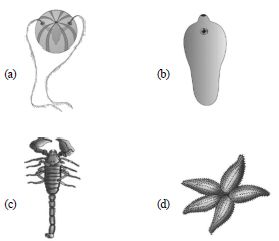
Click to check answer
Click to check answer
Click to check answer
Click to check answer
The transition from aquatic to terrestrial lifestyles required many adaptations in the vertebrate lineage. Which of the following is not one of those adaptations ?
Switch from gill respiration to air-breathing lungs.
Improvements in water resistance of skin.
Alteration in mode of locomotion.
Development of feathers for insulation.
Select the incorrect feature of mollusca from the given statements.
- Terrestrial or aquatic animals having cellular system level of organization.
- Radial symmetrical and acoelomate animals and possesses two germinal layers.
- A file like rasping organ called radula is present.
- Usually dioecious and viviparous animals.
- Examples include Pila, Octopus, and Dentalium.
(i) and (ii) only
(ii) and (iv) only
(i), (ii) and (iv) only
All the five statements.
Which of the following statements (i - v) are correct ?
(i) The pelvic fins of female sharks bear claspers.
(ii) In Obelia, polyps produce medusae sexually and medusae form the polyps asexually.
(iii) Flame cells in platyhelminthes help in osmoregulation and excretion.
(iv) In non-chordates, central nervous system is ventral, solid and double.
(v) Pinnae are present in mammals.
(ii), (iv) and (v)
(i), (iii) and (v)
(iii), (iv) and (v)
(i), (ii) and (iii)
Refer the following animals and identify those which have a fluid filled body cavity with a complete lining derived from mesoderm.
(i) Sycon (ii) Butterfly
(iii) Nereis (iv) Sea fan
(v) Scorpion (vi) Pila
(i) and (iii) only
(ii) and (iv) only
(ii), (iii), (v) and (vi) only
All of these
Which of the following belong to phylum arthropoda?
Bombyx and Apis
Laccifer and Anopheles
Locusta and Limulus
All of the above
Which of the following statements is incorrect ?
Prawn has two pairs of antennae.
Nematocysts are characteristic feature of the phylum cnidaria.
Millipedes have two pairs of appendages in each segment of the body.
Animals that belong to phylum porifera are exclusively marine.
Few cnidarians like corals have a skeleton composed of
calcium hydroxide
calcium sulphate
calcium carbonate
sodium bicarbonate
Tracheae of cockroach and mammal are similar in having
paired nature.
non-collapsible walls.
ciliated inner lining.
origin from head.
Identify the correct characteristics of porifera.
- Commonly known as sea walnuts.
- Presence of ostia and collar cells.
- Exhibit tissue level of characteristics.
- It is the largest phylum of animal kingdom.
- The body is supported by spicules and sponging fibers.
- Contains cnidocytes which is used for defense, anchorage and capturing of prey.
(ii), (v) only
(i), (ii), (vi) only
(i), (ii), (iii), (iv) only
All of these.
The given figure shows some characteristic features marked as chordates. Identify the correct labelling A,B,C and D.
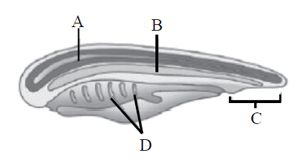
A-Notochord; B-Post-anal part; C-Gill slits; D-Nerve cord
A-Nerve cord; B-Notochord; C-Post-anal part; D-Gill slits
A-Notochord; B-Nerve cord; C-Gill slits; D-Post-anal part
A-Gill slits; B-Post-anal part; C-Nerve cord; D-Notochord
A student brought home a strange animal which he found outside under a rock. It had moist skin, a complete digestive tract, a ventral nerve cord, and had gone through torsion. Identify the phylum of the animal.
Porifera
Annelida
Mollusca
Echinodermata
Which of the following pairs of animals comprises jawless fishes?
Mackerals and rohu
Lampreys and hag fishes
Guppies and hag fishes
Lampreys and eels
Match the terms/feature given in column I with their examples given in column II and select the correct match from the option given below.
| Column-I | Column-II |
|---|---|
| (Term/Feature) | (Examples) |
| A. Gregarious pest | i. Hirudinaria |
| B. Vector | ii. Planaria |
| C. Oviparous with | iii. Sepia indirect development |
| D. Metameres | iv. Aedes |
| E. High regeneration | v. Locust capacity |
A - i, B - ii, C - iii, D - iv, E - v
A - iii, B - v, C - ii, D - iv, E - i
A - iii, B - i, C - v, D - ii, E - iv
A - v, B - iv, C - iii, D - i, E - ii
Identify the figures and select the correct option
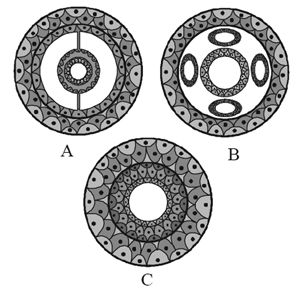
A - Pseudocoelomate; B - Coelomate, C-Acoelomate
A - Coelomate, B - Pseudocoelomate, C- Acoelomate
A - Coelomate; B- Acoelomate; C - Pseudocoelomate
A - Coelomate; B- Acoelomate; C-Eucoelomate
The figure given below shows the germinal layers marked as A, B, C and D. Identify the label showing undifferentiated layer and its location?
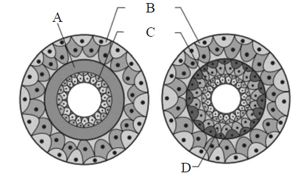
A, Between B & C
B, Between A & C
C, Between C & D
D, Between A & B
Which of the following animals are bilaterally symmetrical?

1 & 2
2 & 4
3 & 4
1 & 3
Refer the figures A, B, C and D given below. Which of the following options shows the correct name of the animals shown by the figures A, B, C and D ?

A – Locust, B – Scorpion, C – Prawn, D – Pila
A – Locust, B – Prawn, C – Scorpion, D – Pila
A – Locust, B – Scorpion, C – Prawn, D – Snail
A – Butterfly, B – Scorpion, C – Prawn, D – Pila
Which of the following animal's body is covered by calcareous shell and unsegmented with a distinct head, muscular foot, and visceral hump?
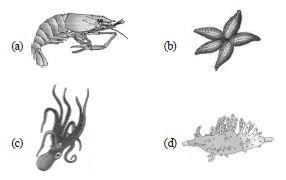
Click to check answer
Click to check answer
Click to check answer
Click to check answer
Which of the following statement is incorrect?
Platyhelminthes has incomplete digestive system.
In coelenterates, the arrangement of cells is more complex.
Nereis is monoecious but earthworms and leeches are dioecious.
Simple and compound eyes are present in the animals of those phylum whose over two-thirds of all named species on earth are arthropods.
The combination of a true coelom and repeating body segmentation allows the annelids (unlike the anatomically simpler worms) to do which of the following?
Attain complex body shapes and thus locomote more precisely.
Move through loose marine sediments.
Be hermaphroditic.
Inject paralytic poisons into their prey.
Flame cells present in platyhelminthes, are specialized in
respiration and absorption.
osmoregulation and circulation.
respiration and excretion.
osmoregulation and excretion.
